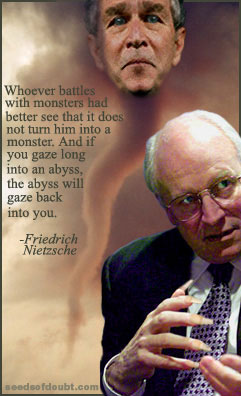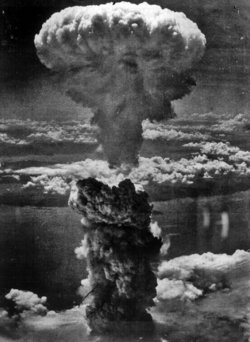....just what rank and file Goopers love!
If this "character" is elected to the highly esteemed office of dog-catcher in bumfuck Arkansas it will be time to shut the nation down and start all over.
I generally like characters. Every town and village has at least one. Cities have many.
But they do not run for president and, if they do, they are no taken seriously.
NYC mayors have frequently been what I would call characters.
To elect one of these characters to be president would be the height of stupidity.
Nevertheless, I do hope he wins the Rethug nomination, simply because his candidacy will keep 9/11 in the headlines, right where it needs to be for our plan to work.
Giuliani's Mayoral Record Is Complicated
By LIBBY QUAID, Associated Press Writer
Saturday, July 21, 2007
Rudy Giuliani boasts that he reined in crime, welfare and taxes in a city once considered ungovernable.
Those claims are intrinsic to the former New York mayor's pitch to Republican voters that he has the combination of competence and toughness they want in a president. Whether his record supports those claims, however, is a matter upon which admirers and critics differ markedly.
Most benchmarks during Giuliani's eight years as mayor, from the start of 1994 to Jan. 1, 2002, suggest dramatic success. The crime rate tumbled by 60 percent. Welfare rolls decreased by 52 percent. Taxes fell by at least 25 percent. While city spending grew, it lagged behind the booming economy of the 1990s.
His record, however, is more complicated than the numbers indicate.
Giuliani was a pugnacious leader. He picked fights with political foes as well as his own police chief and schools superintendent. Any critic — squeegee men, artists, callers to his weekly radio show — was fair game.
In his wake, Giuliani left a trail of detractors who insist he does not deserve all the credit for the good things that happened on his watch.
The city was primed for success as Giuliani took office in 1994.
Thousands of new police officers hired by his predecessor, Democrat David Dinkins, were coming on duty. Thousands of mentally ill homeless people were provided housing and treatment under a program begun by Dinkins and former Democratic Gov. Mario Cuomo.
The economy was growing, pumping billions of dollars into the city treasury. The Dow Jones Industrial Average stood at 3,754.09 on the day Giuliani arrived at City Hall and opened at 10,136.99 the day he left.
"He did some things in the first couple of years in particular that he should get some credit for, particularly the continuing reduction in crime, but I don't think he was an unusually good mayor," said Steven Cohen, a public affairs professor at Columbia University.
"He was actually a capable guy and did a good job," Cohen said. "But I think he had a tendency to see himself as the only person who was smart in the room."
Giuliani's signature issue, crime, is especially important to law-and-order Republican voters. Before winning the mayor's office, Giuliani was a federal prosecutor who put away drug pushers, mob figures and white-collar crooks.
Giuliani was mayor during a period of declining crime rates nationwide. Crime in New York peaked in 1990 and had been dropping for three years before Giuliani took office, according to FBI data. Nationally, violent crime declined 38 percent and property crime declined 33 percent from a modern peak in 1991 through 2005.
The drop was more dramatic in New York. Crime overall decreased by 60 percent between 1993, the year before Giuliani took office, and 2002, when he left. The national crime rate dropped by 24 percent during the same period.
The steep reductions in New York, Giuliani contends, came from a system developed by his police department to map crime patterns and make local police commanders responsible for reducing crime.
"New York City was the only one (of big cities) that had a decline in crime every single year" during that period, Giuliani told Iowa voters recently.
Other big cities copied New York's program — Compstat, short for computerized, or compare, statistics. Giuliani wrote in his 2002 book, "Leadership," that he considered it his crown jewel.
But there was debate, even early on, over who deserved more credit for the drop in crime — Giuliani or William Bratton, the charismatic police chief from 1994 to 1996. Giuliani abruptly fired Bratton after he appeared on the cover of Time magazine as the man responsible for the crime reduction.
Eli Silverman, a professor emeritus at City University of New York's John Jay College of Criminal Justice, thinks Giuliani takes too much credit for the program. "He calls it the crown jewel of his leadership, the implication being it was his baby. There were other parents," Silverman said.
Today, Giuliani has defused the conflict by reconciling with Bratton, now the Los Angeles police chief, and making a point of mentioning Bratton and his aides in speeches.
Under Giuliani, police also cracked down on small-time "quality of life" offenders such as squeegee men and subway turnstile jumpers who often turned out to be responsible for more serious crimes.
Some experts say the new tactics — combined with 12,000 more police officers hired under Dinkins and a merger with transit and housing police — were instrumental in reducing crime.
"So more money was being put into policing, no question," said Silverman, who wrote a book on Compstat. "But money itself is not enough. You need not only more cops, but you need to allocate and deploy them more intelligently, and that's what Compstat was able to do."
Sociology professor Andrew Karmen, who also teaches at John Jay College of Criminal Justice, does not think Compstat deserves as much credit. He cites other factors, such as an improved economy, an influx of immigrants who were generally law-abiding, a shrinking population of young people and more criminals serving jail time. Karmen also cited open admissions at New York City's public colleges, which provided an education to more young people.
Detractors also question whether police abused their power to achieve crime reductions, noting that civilian complaints against police rose 41 percent under Giuliani.
In two high-profile abuse cases, police shot and killed unarmed West African immigrant Amadou Diallo, and Haitian immigrant Abner Louima was beaten and sodomized in a Brooklyn station house.
Officials from Giuliani's administration point out the city made it easier for people to file complaints. In "Leadership," Giuliani notes that police shootings declined — from 81 in 1992 to 26 in 2002.
Giuliani expanded the Compstat approach throughout city government. For example, his administration applied it to job programs, measuring how many people were moved off welfare and into private sector jobs and reporting the numbers to the public.
Welfare rolls under Giuliani shrank by more than half, from more than 1 million to 516,000, according to city and federal records. Unemployment fell from 10 percent to 6 percent.
Giuliani helped tie public assistance to work, requiring people to work in community service jobs in exchange for welfare benefits. Giuliani renamed the city's welfare offices, calling them job centers.
Some welfare recipients, though, compared the community service jobs to indentured servitude and said they did not lead to real jobs.
Advocates for the poor point out that even though poverty rates fell under Giuliani, nearly one in five New Yorkers remained below the poverty line, well above the national rate.
Yet the rest of city residents saw fatter paychecks as the economy continued to expand. Personal income rose by an average of 5.8 percent annually while Giuliani was mayor, according to city and federal data.
Personal income is a good way to measure economic growth, said Chuck Brescher, research director of the independent Citizens Budget Commission.
By that and several other measures, city spending grew more slowly than the economy, at about 4.1 percent, according to the nonpartisan, nonprofit organization that monitors New York City and New York state government.
At the same time, Giuliani cut taxes on commercial rent, personal and business income and general sales. The cuts grew steadily as the economy grew, from 0.2 percent in 1995 to 6.7 percent, or $1.6 billion, when he left office, CBC said.
For managing that in liberal New York, he gets good grades from the anti-tax group Club for Growth.
"He has his blemishes, but we thought his constructive policies in the face of such vigorous opposition was really noteworthy," said Pat Toomey, a former Republican congressman from Pennsylvania who heads that group.
One way Giuliani kept spending in check was to cut city employees by an estimated 8 percent, not counting teachers.
Giuliani hired thousands more teachers, although the four-year high school graduation rate remained stubbornly unchanged at 52 percent during his tenure. Officials from Giuliani's administration point out Giuliani attempted to take control of the city school system, calling it "dysfunctional" and saying it should be "blown up."
As one of the top GOP contenders for the White House, Giuliani is drawing increased scrutiny for his mayoral record.
"The question is, how much does New York help him and how much does New York hurt him?" said Scott Huffman, political science professor at South Carolina's Winthrop University. "Remember, he's running in a Republican primary, and a lot of so-called red-staters don't have a fondness for that great city."
___
Associated Press writer Stephen Ohlemacher contributed to this report.
(In accordance with Title 17 U.S.C. Section 107, this material is distributed without profit to those who have expressed a prior interest in receiving the included information for research and educational purposes. The Lantern has no affiliation whatsoever with the originator of this article nor is The Lantern endorsed or sponsored by the originator.)
....And The Truth Shall Set Us Free







No comments:
Post a Comment